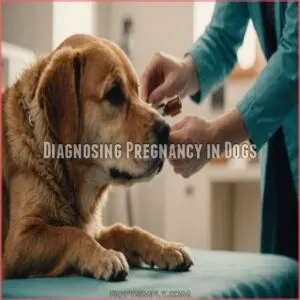This site is supported by our readers. We may earn a commission, at no cost to you, if you purchase through links.
 So, you’re curious about how long is a dog pregnant?
So, you’re curious about how long is a dog pregnant?
Typically, a dog’s pregnancy, or gestation, lasts about 63 days, give or take a day or two.
Factors like breed size, age, and health can cause slight variations.
Just like a human, your furry friend might start nesting or show signs of a growing belly.
Make sure she gets a balanced diet, regular vet check-ups, and a comfy whelping box ready for the big day.
Keep in mind, not all pregnancies are textbook, so knowing the signs and having a vet’s number handy can save you from going barking mad!
Curious about what comes next?
Table Of Contents
- Key Takeaways
- Dog Pregnancy Duration
- Signs and Symptoms of Pregnancy
- Diagnosing Pregnancy in Dogs
- Caring for a Pregnant Dog
- Preparing for Whelping
- Whelping and Labor
- Common Pregnancy Complications
- Litter Size and Estimation
- Post-Pregnancy Care
- Responsible Dog Breeding
- Frequently Asked Questions (FAQs)
- How long does a dog pregnancy last?
- When does a dog give birth?
- What is the normal gestation period of a dog?
- How long does it take a dog to get pregnant?
- How many months is a dog pregnant for?
- Can a dog be 3 months pregnant?
- How long after mating can you tell a dog is pregnant?
- How many puppies can a dog have for the first time?
- How do dogs hormonal changes affect behavior?
- Can a dogs diet influence pregnancy success?
- What are early indicators of canine false pregnancy?
- How does a dogs age impact pregnancy health?
- What breeds have unusual pregnancy durations?
- Conclusion
Key Takeaways
- A dog’s pregnancy typically lasts about 63 days, or roughly two months, with slight variations depending on breed and litter size.
- You’ll notice physical changes like a swollen belly and enlarged nipples, as well as behavioral shifts such as nesting and increased affection during your dog’s pregnancy.
- You should provide proper nutrition, regular vet check-ups, and prepare a whelping box as your dog’s due date approaches.
- After birth, you’ll need to monitor both the mother’s health and care for the newborn puppies, including frequent feeding and early socialization.
Dog Pregnancy Duration
So, if you’re expecting a litter of adorable Malshi puppies, you’ll want to know all about malshi puppies. So, you’re curious about how long your furry friend will be carrying her puppies?
A dog’s pregnancy, or gestation, typically lasts around 63 days, though it can vary slightly depending on the breed and the size of the litter.
Average Length of Pregnancy
So, you’re wondering how long a dog is pregnant?
Typically, canine pregnancy lasts about 62 to 64 days, or roughly two months.
As the due date approaches, it’s important to recognize dog labor signs, such as nesting behavior and a body temperature drop, to make sure you provide proper care and support for your dog.
This timeline, though, can seem like an eternity when you’re anxiously awaiting the arrival of those adorable pups.
Just remember, from early pregnancy to late, each stage brings unique developments in your pregnant dog’s journey.
Factors Affecting Pregnancy Length
Understanding the average length of a dog’s pregnancy sets the stage for the factors affecting it.
Breed plays a major role. Smaller breeds tend to have shorter pregnancies, while larger breeds may stretch those weeks.
Litter size also matters; a larger litter might lead to an earlier delivery.
Age, health, and nutrition can sway the timing, highlighting each dog’s unique journey.
Signs and Symptoms of Pregnancy
Spotting a dog’s pregnancy can be a bit tricky, but you’ll notice physical changes like a swollen belly and enlarged nipples, alongside behavioral shifts such as nesting and increased affection.
These signs, coupled with common symptoms like increased appetite and occasional vomiting, help you determine if your furry friend is expecting.
Physical Changes
You might notice some physical changes if your dog is pregnant.
Keep an eye out for these signs:
- Nipple changes: They become more prominent as milk could be on the way.
- Belly growth and weight gain: Cocker Spaniels reach full size around 9 to 12 months, when significant growth milestones are achieved. Your dog starts looking a bit rounder.
- Coat changes and vaginal discharge: These subtle hints signal your dog’s reproductive journey.
Behavioral Changes
As your dog’s pregnancy progresses, you might notice a few quirks.
She may develop a nesting instinct, rearranging blankets or toys.
Food cravings could have her eyeing your dinner plate.
Affection levels might spike, or she might grow a bit snappy.
Anxiety isn’t uncommon either.
These shifts are normal, so keep calm and support her through these changes.
Common Symptoms
Spotting pregnancy in your dog isn’t rocket science.
Look for nipple changes and appetite shifts.
Nesting behavior may kick in as she prepares for newborn puppies.
Watch her energy levels; she might tire easily.
Mood swings are common too—one moment cuddly, the next irritable.
These signs help you navigate this exciting chapter with your furry friend.
Diagnosing Pregnancy in Dogs
Confirming your dog’s pregnancy isn’t always obvious; you’ll need to use veterinary diagnostic tests like ultrasounds or blood work for a definitive answer.
These tests, along with abdominal palpation, provide the most accurate confirmation of pregnancy and can help determine the number of puppies.
Diagnostic Testing
Feeling unsure about your dog’s pregnancy signs? Diagnostic testing offers reliable confirmation.
Here’s a handy list:
- Ultrasound: Safe and detailed, it confirms pregnancy around 25-35 days.
- Blood Test: Measures hormone levels; schedule it on days 25-30.
- X-rays: Effective after day 55 for fetal count.
- Cost & Risks: Consider budget and vet guidance.
Stay informed and confident!
Abdominal Palpation
Abdominal palpation, your secret weapon in diagnosing dog pregnancy, requires timing and technique.
Ideally done around days 28-30, it involves feeling for tiny, developing puppies, while also considering the need for dog pregnancy care products.
Leave this to an experienced vet to guarantee palpation accuracy and minimize risks.
| Timing | Expertise Required |
|---|---|
| Day 28-30 | Experienced Vet |
| Risks | Palpation accuracy |
Ultrasound Examination
Curious about your dog’s pregnancy? An ultrasound examination is a great way to find out. It’s commonly done between days 25 and 35 of gestation, offering quick results with high accuracy.
Plus, ultrasounds are safe and straightforward. While the cost varies, knowing your pup’s status without a hitch is priceless. So, consider this timely diagnostic tool for peace of mind.
Blood Tests
Ultrasounds might thrill you with puppy heartbeats, but blood tests seal the deal with hormone levels.
They confirm pregnancy about 25 to 30 days after mating.
Rely on these tests for their accuracy and timely results.
- Quick early detection
- Reliable pregnancy confirmation
- Measures hormone levels
- Simple vet visit
By checking blood, you’ll know exactly where your pup stands.
X-rays
Those X-ray machines at the vet’s are like a crystal ball for confirming your dog’s pregnancy around 55 days.
They safely reveal the puppy count and can flag skeletal abnormalities, helping you prepare for whelping time.
It’s important to get the timing just right to make sure everything’s visible without causing harm, so trust your vet’s guidance.
Caring for a Pregnant Dog
Caring for a pregnant dog involves ensuring she receives balanced nutrition and regular veterinary check-ups to monitor her health.
You should maintain her normal exercise routine, adjusting as her pregnancy progresses, to keep her fit without overexertion.
Proper Nutrition
Now that you’ve confirmed your dog’s pregnancy, let’s talk food.
A balanced diet is key, focusing on high-quality proteins, essential vitamins, and minerals such as folic acid and iron needs.
If she’s already eating well, you might only need to slightly increase her food portions as her belly grows and she gains weight.
Around week six or seven, ask your vet about supplements.
A consistent feeding schedule helps too, especially as she nears her due date.
Remember, it’s all about supporting her and those growing pups!
Exercise and Activity
Wondering how much exercise is safe for a pregnant dog?
Gentle walks are ideal to keep her fit without overdoing it.
Remember, activity limits are essential, especially as pregnancy progresses.
Watch for signs of fatigue; your pup may tire more quickly than usual.
Exercise benefits both her and the puppies, so keep it simple, and avoid vigorous activities.
Veterinary Visits
Regular veterinary visits during your dog’s pregnancy are essential for monitoring her health and the puppies’ development.
Schedule appointments for pregnancy tests and a vaccination schedule check-up.
Your vet can also provide emergency care tips and whelping assistance.
Don’t hesitate to ask questions; it’s like having a trusted co-pilot guiding you on this exciting journey of pregnant dog care.
Preparing for Whelping
As whelping approaches, you’ll need to set up a cozy, safe whelping box and gather key supplies like towels and a thermometer.
Knowing your role during labor means you’re ready to support your dog through the birthing process.
Setting Up a Whelping Box
Preparing your dog for motherhood? Setting up a cozy whelping box is on the to-do list.
Think Goldilocks: just the right size—not too big or too small.
Also, consider the crate size for the new puppies to avoid crate accidents and anxiety.
Here’s your guide:
- Materials: Choose easy-to-clean surfaces.
- Location: Pick a quiet, private area.
- Temperature: Make sure it’s warm and comfy.
- Supplies: Consider pads for easy cleanup.
Whelping Supply Checklist
Creating a whelping supply checklist is important for a smooth experience.
Make certain you have whelping box essentials like towels, a heat lamp, and puppy care supplies ready.
Stock up on proper dog pregnancy food to support your dog’s nutritional needs during this critical period.
Keep an emergency contact list nearby and have labor monitoring tools handy.
Don’t forget clean-up materials, because puppies aren’t known for tidiness!
Being prepared minimizes stress when the big moment arrives.
Role During Labor
Now that your whelping kit’s ready, let’s talk about your role during labor.
It’s a team effort! You’ll be providing Labor Support Tips, mainly by:
- Monitoring Fetal Health – watch for signs of distress.
- Assisting Delivery – be ready to help if needed.
- Recognizing Distress Signs – know when to call the vet.
- Managing Complications – stay calm and follow your vet’s advice.
Remember, you’re an essential part of this exciting process!
Whelping and Labor
When your dog’s due date approaches, understanding the stages of labor helps you provide the best support.
From early contractions to potential complications, being prepared guarantees a smoother whelping process for both the mother and her new puppies.
Stages of Labor
You’ve prepared the whelping box, and now it’s time for labor.
In stage one, your dog might act restless or hide as contractions begin. Stage two is all about delivering puppies. Finally, in stage three, placentas follow. Keep an eye out for puppy distress signs and use effective labor support techniques.
| Stage | Action | Key Focus |
|---|---|---|
| Stage 1 | Contractions start | Dog’s behavior changes |
| Stage 2 | Puppies are delivered | Timing and support |
| Stage 3 | Placentas follow | Managing placental delivery |
Normal Labor Process
Once those early contractions kick in, be ready for the main event: the normal labor process.
Puppies generally arrive within one to twelve hours, depending on the litter size.
It’s essential to have your whelping environment beforehand. You might assist by gently guiding puppies or ensuring their first breaths.
Remember, regular prenatal checkups prepare you for stable puppy delivery timing, aiding postpartum recovery.
Potential Complications
After the normal labor process, it’s wise to keep an eye out for potential complications.
Puppy distress may signal a need for professional help, especially if you notice placenta issues or signs of a uterine infection.
Fetal abnormalities might require an emergency cesarean for a safe delivery. Being prepared helps prevent these hiccups from becoming major woes.
Common Pregnancy Complications
As you care for a pregnant dog, it’s important to be aware of common complications that might arise.
Such issues include false pregnancy or unexpected mating.
Understanding these issues and knowing options like mismating injections can help you safeguard your dog’s well-being throughout her pregnancy journey.
False Pregnancy
Sometimes, after you’ve prepared for whelping, your dog may exhibit signs of a false pregnancy.
This condition mimics real pregnancy due to hormonal imbalances, leading to symptoms such as nesting or acting as if she’s pregnant with puppies, which can make it difficult to distinguish from a real pregnancy, especially if you’re not following a regular vet visit schedule.
These phantom birth behaviors may seem convincing, but they pose misdiagnosis risks.
Consult a vet to manage psychological symptoms and confirm her health.
Accidental Pregnancy
You’ve faced false alarms, but what about the real thing?
Accidental pregnancies in dogs can lead to unplanned litters, adding stress and responsibility.
Preventing unwanted breeding is key. Consider spaying options or canine birth control to maintain control over your pet’s life.
If an accident happens, consult your veterinarian about emergency contraceptives to manage the situation effectively.
Mismating Injections
Oops, an unplanned pregnancy? Don’t panic!
For accidental pregnancies, your vet can administer mismating injections for Pregnancy Termination, a form of Emergency Injections, within 45 days of mating.
This is a safe option for Fertility Control, but timing is key.
Discuss Contraceptive Options and Mating Timing with your vet to prevent future surprises.
They can help you navigate this tricky situation.
Litter Size and Estimation
Determining how many puppies your dog might’ve can be as puzzling as counting jelly beans in a jar.
Factors like breed and health influence litter size, and while ultrasound scans can help with estimates, they don’t always give an exact number.
Factors Affecting Litter Size
Moving from complications, let’s chat about what influences litter size.
Genetics impact the number of puppies; larger breeds like Labradors usually have more pups than smaller breeds, like Dachshunds.
Nutrition effects are real; a balanced diet boosts litter health.
Don’t forget age influence and health conditions. An older dog or one with health issues might’ve smaller litters.
Estimating Litter Size
Thinking about litter size? Factors like breed influence and genetic factors play a role in determining a dog’s temperament, as studies have shown that genetics determine my puppy’s temperament, but it’s not all cut and dried.
To estimate litter size, you might consider these:
- Consult an experienced vet for insights.
- Consider breed-specific traits and histories.
- Understand that variations are normal.
- Monitor signs as pregnancy progresses for clues.
Ultrasound Scans
An ultrasound helps you estimate your dog’s litter size, offering valuable insights into expected puppy count.
Veterinarians often perform these scans around 30 days into pregnancy.
| Aspect | Details |
|---|---|
| Frequency | Around day 30 |
| Cost | Varies; check locally |
| Puppy Count | Estimated via imaging |
| Image Interpretation | Vet’s expertise essential |
It’s a non-intrusive way to monitor your dog’s pregnancy.
Post-Pregnancy Care
Once your canine companion has given birth, it’s essential to focus on ensuring both her health and the well-being of her puppies.
Monitor her recovery closely, providing nutrition and veterinary care, while watching over the newborns for any signs of distress or difficulty.
Caring for Newborn Puppies
Cradle your puppies in comfort and warmth; they’re like tiny marshmallows needing tenderness.
Keep their nest clean and cozy.
Puppy feeding involves nursing every 2 hours—nature’s way of delivering nutrients.
Observe their play; early socialization helps shape personalities.
Be vigilant for whelping complications, but mostly, let the joyful sounds of tiny paws remind you of the wonder they bring.
Monitoring The Mother’s Health
Now that the pups are here, don’t forget about mom.
She’s worked hard.
It’s important to make sure she’s getting the right nutrients, consider adding dog pregnancy vitamins to her diet.
Here’s what to watch for:
- Weight gain: Is she eating enough?
- Appetite changes: Any sudden shifts?
- Energy levels: Is she overly tired or lethargic?
- Nipple changes: Look for any signs of infection.
- Stress levels: Is she showing signs of stress?
Regular check-ups with your vet are important.
She deserves some pampering after all that!
Responsible Dog Breeding
When you’re considering breeding your dog, it’s essential to balance passion with ethical responsibility, recognizing the significant financial and emotional commitments involved.
Ensuring the right care for pregnant dogs and newborn puppies often requires extensive planning and resources, from veterinary consultations to daily nurturing once they’re born.
Cost Considerations
Considering dog breeding comes with costs that can add up quickly.
Veterinary care, emergency vet visits, breeder fees, and puppy supplies are typical expenses. You’ll also need to budget for food costs, which can be substantial.
Here’s a simple breakdown:
| Expense | Estimated Cost | Priority Level |
|---|---|---|
| Veterinary Care | $200-$500 | High |
| Breeder Fees | $300-$800 | Medium |
| Puppy Supplies | $100-$200 | Essential |
Hand-Rearing Puppies
Raising puppies, you’ll discover it’s a rollercoaster of feeding, health checks, development, and countless challenges.
Selecting breeds like Labrador Retrievers for kids can be a great starting point.
Sleepless nights and endless feeding schedules test your patience, but seeing those tiny tails wag is all the reward you need.
Make sure you provide proper nutrition and regular vet visits.
Puppies grow fast and go through four distinct growth stages, including the neonatal period, transitional period, socialization period, and juvenile period, understanding puppy growth stages. Puppies grow fast, so arm yourself with knowledge and plenty of love to navigate this wild journey successfully.
Ethical Breeding Practices
After nurturing pups by hand, you’d want to focus on ethical breeding practices. Responsible breeders guarantee puppy health through genetic testing and ethical sourcing. Breeder ethics matter because every litter counts for future generations.
Consider:
- Conduct thorough genetic testing
- Prioritize puppy health with regular vet visits
- Focus on ethical sourcing of dogs
- Adhere strictly to breeder ethics
- Plan and space litters wisely
Frequently Asked Questions (FAQs)
How long does a dog pregnancy last?
Did you know that a dog’s pregnancy averages 63 days?
It’s about nine weeks, give or take a few days depending on the breed.
You’ll see noticeable changes in your dog as the weeks progress.
When does a dog give birth?
Your dog will give birth about 63 days after conception.
It’s a good idea to prepare a cozy whelping area as the due date nears.
Make sure to monitor for signs of labor and consult your vet.
What is the normal gestation period of a dog?
A dog’s normal gestation period lasts about 62 to 64 days.
Think of this as close to two months, with variations based on breed and litter size.
It’s short and sweet but quite the journey!
How long does it take a dog to get pregnant?
You might wonder about the journey of a canine pregnancy.
Dogs take about two months, around 62 to 64 days, from conception to delivery.
Each breed varies, but this period reflects their fascinating development into puppies.
How many months is a dog pregnant for?
A dog’s pregnancy lasts about two months, typically ranging from 62 to 64 days.
This period is short, so you’ll notice rapid changes as the puppies develop swiftly within this brief, exciting span of time.
Can a dog be 3 months pregnant?
Dogs can’t be pregnant for three months.
Their pregnancies last around 62-64 days, just over two months.
If you’re concerned about your dog’s pregnancy duration, consult a vet for guidance and make sure everything’s on track.
How long after mating can you tell a dog is pregnant?
Approximately 28 days after mating, you can confirm a dog’s pregnancy through ultrasound, revealing a tiny, beat-bopping heartbeat.
It’s like a pup party in her belly, but remember, not all symptoms guarantee a prenatal celebration.
How many puppies can a dog have for the first time?
First-time moms can have anywhere from one to twelve puppies. Breed size, such as the relatively compact size of English Bulldog growth stages, plays a big role; smaller breeds usually have smaller litters. It’s always a surprise!
How do dogs hormonal changes affect behavior?
Hormonal changes during dog pregnancy can lead to increased affection, irritability, and nesting behavior.
You might notice your dog gets tired more easily or even acts like a detective sniffing around for the perfect nesting spot.
Can a dogs diet influence pregnancy success?
Your dog’s diet can greatly influence pregnancy success.
A balanced, nutritious diet supports the health of both mother and puppies.
Talk to a vet to make sure she’s getting the right nutrients, especially in protein and vitamins.
What are early indicators of canine false pregnancy?
Did you know that up to 50% of unspayed female dogs may experience false pregnancies?
Look for signs like swollen nipples, nesting behavior, and minor weight gain.
These dogs might also carry toys as if they’re puppies.
How does a dogs age impact pregnancy health?
Age greatly impacts your dog’s pregnancy health.
Younger pups may struggle with maternal instincts, while older dogs face higher risks.
Aim for breeding between 2-5 years old.
Regular vet check-ups are essential to monitor potential age-related complications.
What breeds have unusual pregnancy durations?
Picture a doggy maternity ward – most pups arrive like clockwork, but some breeds march to their own beat.
While the average canine pregnancy lasts 63 days, Bulldog and Chihuahua pregnancies can vary slightly.
It’s nature’s quirky twist on puppy delivery!
Conclusion
Isn’t it ironic? We’ve spent all this time learning about dog pregnancy, and yet, we still can’t predict when our own lives will go to the dogs!
But seriously, understanding how long a dog is pregnant is essential for every pet owner.
From the 63-day gestation to the signs, care, and preparation needed, you’re now equipped to handle your furry friend’s journey to motherhood.
Remember, each pregnancy is unique, so stay vigilant, consult your vet, and embrace the miracle of canine life.
Happy puppy-planning!

















